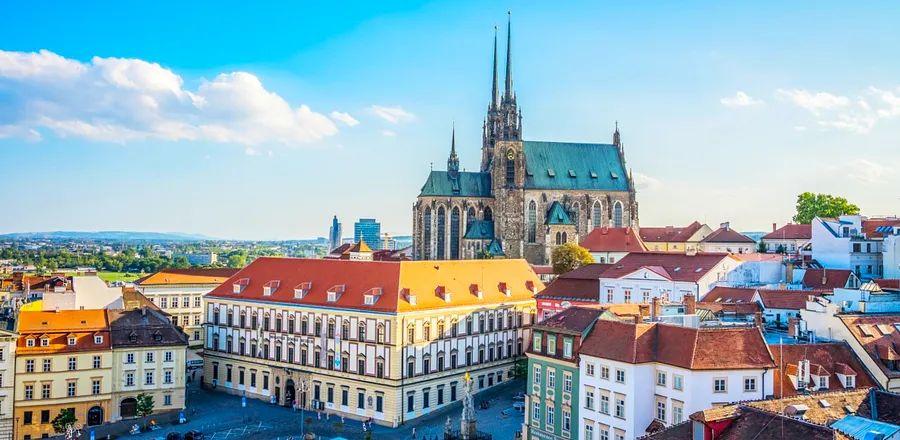This Music-Infused City Is Emerging from Prague’s Shadow

Pronounced Burr-NO, ideally with a luxuriously rolled “r,” Brno, Czechia’s second-largest city, is about a quarter of Prague’s size and attracts very few international tourists. Yet it is Brno, not the capital, that has earned the title of one of UNESCO’s Cities of Music, recognizing its vibrant network of bars, nightclubs, and concert venues, along with its exceptional festival lineup. The local music scene ranges from the banjo punk sounds of homegrown band Poletíme to JazzFestBrno, which in 2024 will feature Grammy Award–winning artist Samara Joy. From the acoustically advanced Sono Centrum to the majestic medieval walls of Špilberk Castle, where the city’s philharmonic orchestra performs, there are few places in Brno that don’t resonate with music.
During the summer, the streets themselves—filled with an eclectic mix of communist-era concrete blocks, pastel-hued art nouveau buildings, and sleek modernist homes—come alive with sound. In July, the Pop Messe festival, now in its fourth year, attracts alternative music acts from all over Europe. In August, free outdoor concerts spread throughout Brno’s compact center as part of the annual Music Marathon. Some performances take place in the city’s many hidden courtyards, while others light up busy squares like the Vegetable Market, where musicians entertain alongside fruit stalls and food trucks.

Photo by Simon Bajada (left); Ezra Ulanday/Unsplash (right)
Brno’s nightlife and clubs have long embraced the underground scene. “There has always been a robust underground culture here,” explains Martin Kozumplík, who manages one of the city's favorite venues, Kabinet Múz. “Growing up during the communist era, it seemed like everyone was in a band.”
With its floor-to-ceiling windows and houseplant decor, Kabinet Múz operates as a vegan café during the day, offering fried tofu “sushi” bowls and aromatic homemade soups, all while spinning records from its own label. By night, it attracts a crowd of around 300, who enjoy pivo (beer) in the back room during indie rock or electronica performances.
Brno's legacy as the capital of Moravia—a renowned winemaking area with a rich tradition of folk music and dance—has influenced its musical landscape. Additionally, its proximity to major cities like Vienna and Prague means that many touring artists stop here. Celebrating the bicentennial of 19th-century Bohemian composer Bedřich Smetana, known for his operas and symphonic works, 2024 has been named the national Year of Czech Music, with Brno at the heart of the festivities.
Brno's artistic influence goes beyond just music. The recently renovated Museum of Applied Arts, established in 1873 and located in a three-story Renaissance revival building adorned with fin-de-siècle decor, has undergone a transformation by Czech architect Ivan Koleček. Its exhibits feature Lucie Koldová’s elegantly curved modern chairs and tables floating next to catwalks that stretch across a sunlit atrium. There’s even a café inspired by 2001: A Space Odyssey, where a robotic arm serves cappuccinos topped with your photo in the foam.
At the same time, a new culinary scene is flourishing in Brno; be sure to visit the farm-to-table bistro Atelier or the Italian eatery Castellana Trattoria. At the creative cocktail bar Super Panda Circus, drinks come as part of an interactive storytelling experience where guests play a role. For accommodations, consider the 37-room Hotel Avion, which reopened in 2022 after six years of renovations and decades of disrepair. This gem reflects the city’s 1920s fascination with functionalist architecture and stands out as an architectural marvel at only 26 feet wide—truly a unique find in Brno.
Travel Planning Tips
- Explore More: The tour operator Tic Brno provides English-speaking excursions led by experts on local cultural highlights, covering everything from art nouveau architecture to baroque landmarks. One tour is dedicated to the city's theaters and music venues.
- Unique to Brno: Brno is home to Europe’s second-largest ossuary, containing 50,000 human skeletons within the catacombs beneath St. Jacob’s Square. This collection of bones, dating back to the 15th to 18th centuries, was uncovered 22 years ago and opened to the public in 2012.
To see our complete list of top destinations for this year, check out Where to Go in 2024.
Evaluation :
5/5



